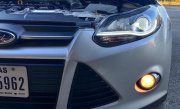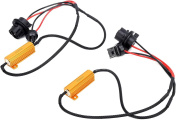
LED headlights become more and more popular in the automotive industry. Many carmakers offer LED headlights as an option or standard feature. At the same time, smart headlights are still a rarity. What do you know about them? How do they work?
What are smart headlights?

Adaptive driving beam (ADB) headlights, also known as smart headlights, can produce more light to the road ahead without blinding oncoming car drivers. They do this by using a system of sensors and cameras to constantly monitor the area around the car, and adjust the beam pattern accordingly. The result is a headlight beam that's always optimized for the current driving conditions, providing better visibility without dazzling other road users.
Smart headlights use a combination of sensors and cameras to constantly monitor the area around the car. These sensors detect when there's an oncoming car and automatically adjust the headlight beam pattern to avoid dazzling the driver. The result is a headlight beam that's always optimized for the current driving conditions, providing better visibility without blinding other road users.
Physical shutters, such as an umbrella that blocks the sun, are used by some ADB smart headlights to block oncoming traffic from glare. Others are made up of many LEDs and may be switched off selectively so that light does not shine directly into the eyes of drivers in front or behind a vehicle. Thus, more light can be cast on the road without dazzling others.
What cars have smart headlights?
Mercedes-Benz calls its headlights an "Intelligent Light System," while Genesis refers to its package as the "Adaptive Cornering System." The technology is available on many Porsche vehicles, including the Taycan 4S pictured in this story. Lincoln and Lexus also provide it as an option on some models.
All these cars are available with LED headlights, and some use physical shutters while others have an array of LEDs that can be selectively switched off. If you're not sure whether a car has ADB headlights, there are a few things you can look for. First, check to see if the vehicle has LED headlights. If it does, there's a good chance it also has ADB headlights. You can also look for cars that offer an "Intelligent Light System" or "Adaptive Cornering System." These are both names for ADB headlights. Finally, check the car's owner's manual or ask the dealer to see if the car has ADB headlights.
Benefits
The main benefit of smart headlights is that they provide better visibility for drivers, especially at night. This can potentially reduce the number of accidents that occur during nighttime hours. In addition, smart headlights can also help to reduce glare for oncoming traffic, making it easier for drivers to see the road ahead.

Drawbacks
One potential drawback of smart headlights is that they may be more expensive than traditional headlights. In addition, some people may not like the way they look, as they can be quite different from traditional headlights. Finally, it is possible that smart headlights could create more light pollution, as they may shine brighter than traditional headlights.
Why are smart headlights illegal in the US?
Adaptive beams are illegal according to this regulation because they don't have high and low beam headlights that are separate. Adaptive beams can adjust how bright they shine as well as the area it illuminates, but does so with only one LED light. The USA has strict regulations about headlight design. One of the requirements is that there must be a physical separation between the high and low beam headlights. Adaptive beams don't have this separation, as they use only one LED light that can adjust its brightness and beam pattern. This makes them illegal in the US.
However, in November 2021, the infrastructure bill formally legalizes adaptive headlights after a long battle. Although there are 60 percent fewer cars on the road at night, more than 40 percent of fatal car accidents occur during nighttime hours. Moreover, according to the Insurance Institute for Highway Safety, crash rates per mile are nearly 20 percent lower for vehicles with headlights that earn a good rating in the institute’s headlight rating program, as opposed to those with poor-rated headlights.
After this rule change, many carmakers are expected to make the switch to adaptive headlights. This will provide better visibility for drivers, and potentially reduce the number of accidents that occur at night. In a 2015 study completed in Sweden, it was discovered that Adaptive Headlights (ADHLs) significantly reduce single-vehicle injury crashes for passenger cars during darkness by 39 percent. After that, the Insurance Institute for Highway Safety in the United States conducted its own study and found that vehicles with ADB headlights had 4 percent fewer nighttime crashes per 10,000 insured vehicle years than vehicles without them.
What are other DOT-approved LED headlights?
All headlights and tail lights must be DOT approved in order to be legal for operation on all roads and highways throughout the United States. Lighting without DOT approval is only meant for off-road use, and it is not permissible to use on all US roads and highways. DOT or the Department of Transport usually approves LED lights that have clear or white light. Therefore, if you’re looking for a LED headlight that has been approved by the DOT, it needs to emit a clear or white light. You can find many different DOT-approved LED headlights on the market today.
What makes a light DOT approved? DOT-compliant lighting fixtures adhere to section 108 requirements put in place by the Federal Motor Vehicle Safety Standards (FMVSS). The FMVSS oversees all aspects of automotive lighting, from signaling devices to reflectors. You'll see the FMVSS logo, which is a certification mark, on all products that meet these standards.

DOT compliance is voluntary, but companies that choose not to comply with these standards are at risk of being fined by the National Highway Traffic Safety Administration (NHTSA). In addition, their products may be removed from store shelves and they could face legal action from consumers who were injured as a result of using their products.
It's important to note that DOT compliance does not mean that a product is necessarily safe. It simply means that the product meets the minimum safety requirements put in place by the federal government.
Conclusion
Smart headlights are a new type of headlight that is becoming increasingly popular. They offer many benefits over traditional headlights, including better visibility and the potential to reduce accidents. However, they are not legal in all states and jurisdictions. Be sure to check the laws in your area before purchasing or installing smart headlights on your vehicle.








